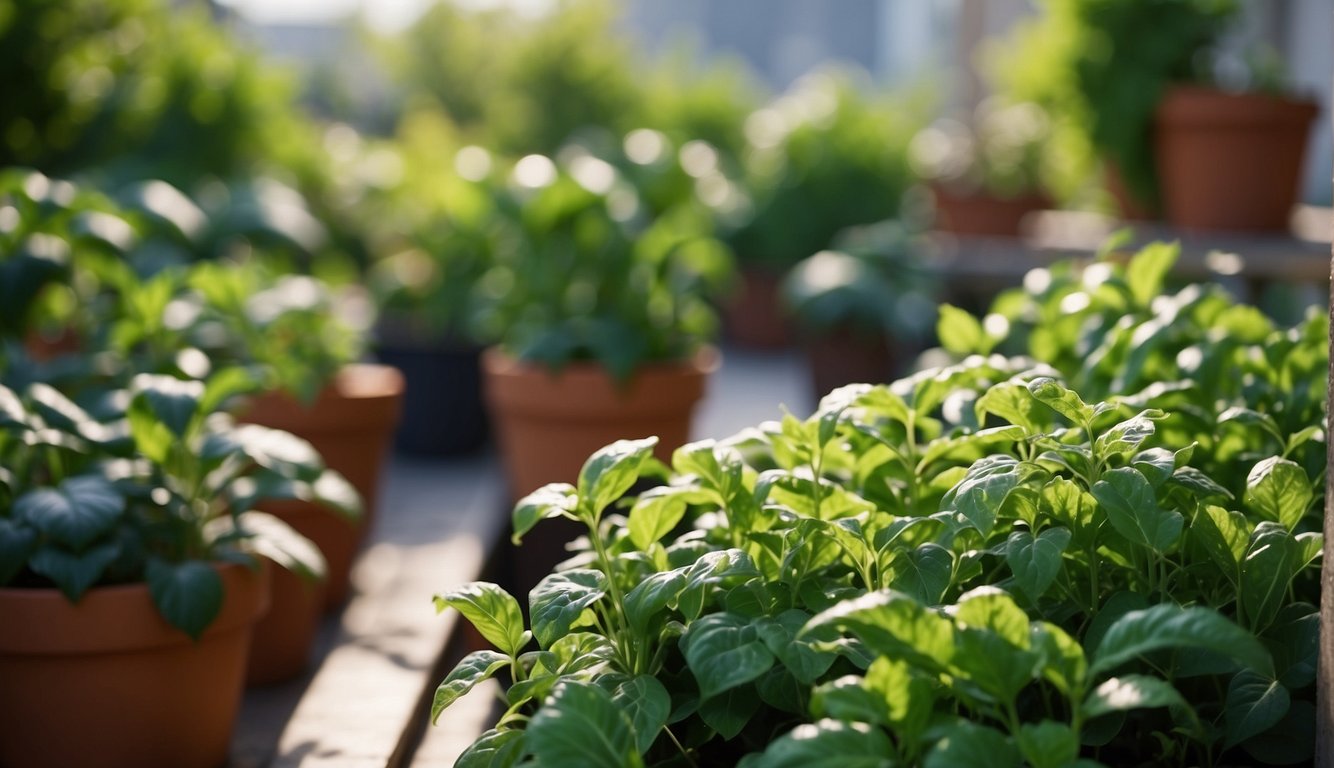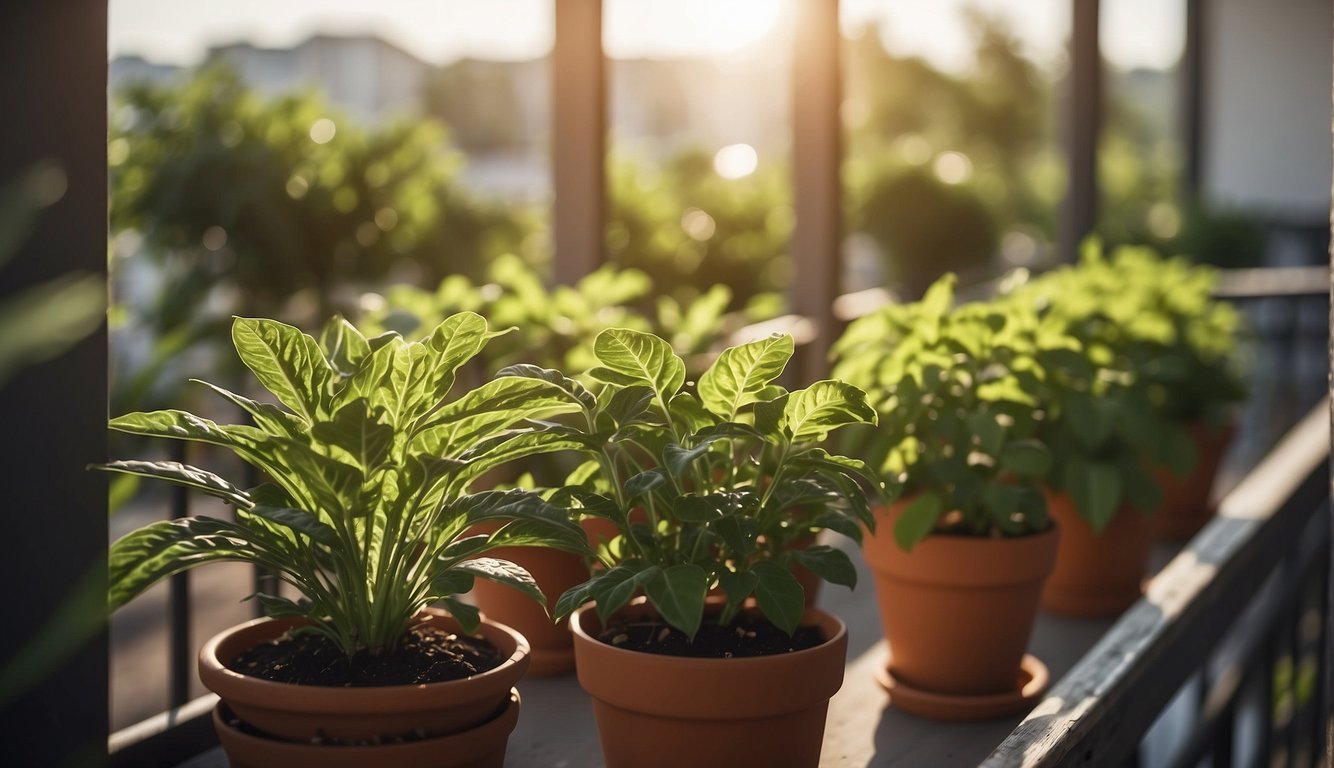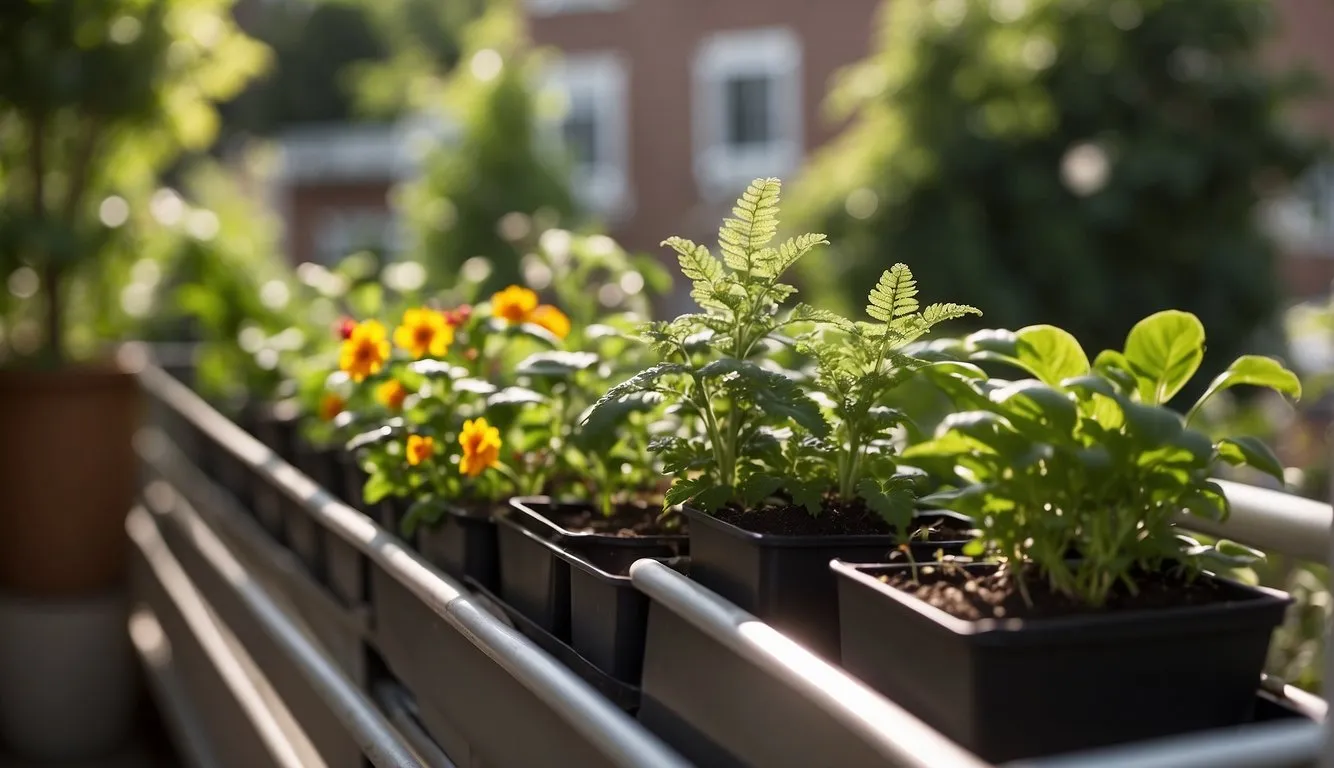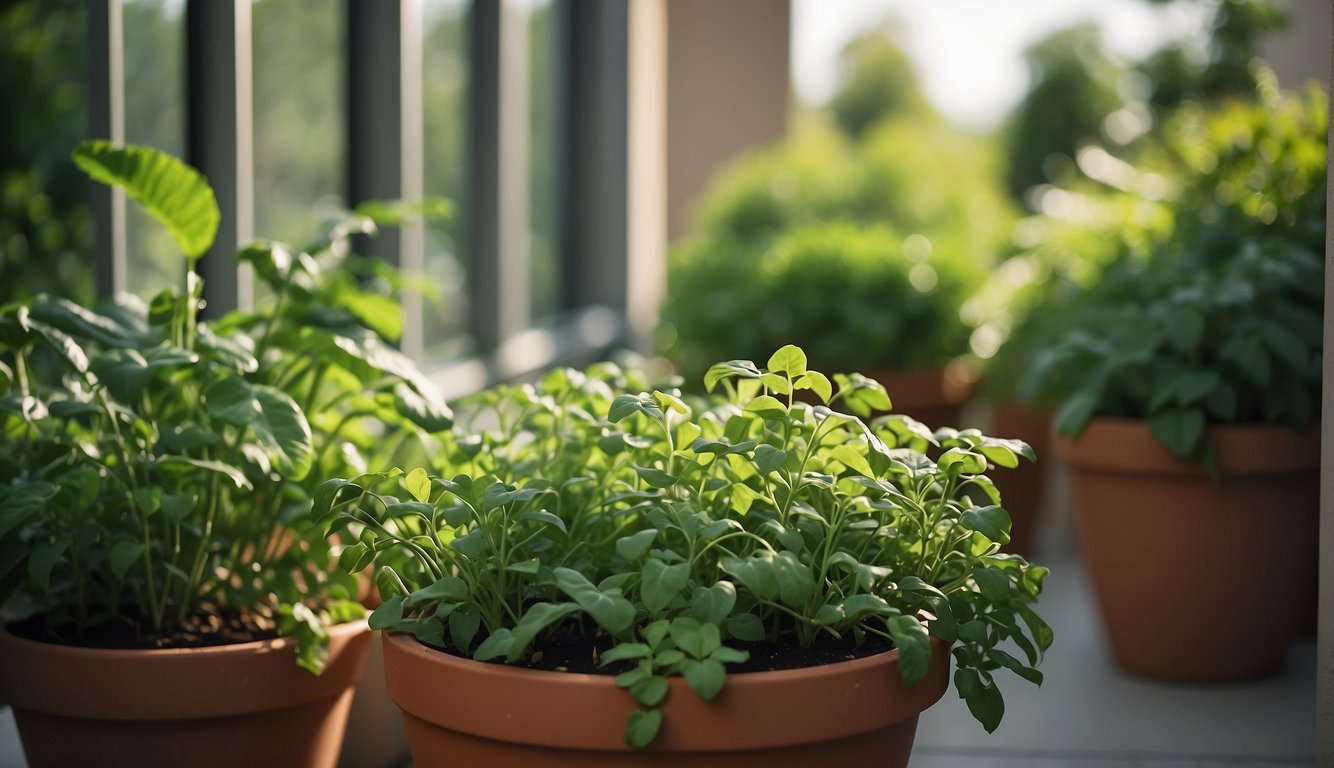Water-efficient balcony gardening is an innovative and sustainable way to grow plants in urban environments. With limited space and resources, balcony gardening can be an excellent solution for those who want to enjoy fresh produce and beautiful flowers. Understanding water-efficient gardening techniques is essential to ensure that your plants thrive while minimizing water usage.

Choosing the right plants for your balcony garden is crucial to ensure that they are well-suited to your environment and require minimal water. Innovative gardening techniques such as drip irrigation, self-watering containers, and rainwater harvesting can help you maximize water efficiency. With soil and water management techniques, you can create a thriving garden that is both beautiful and sustainable.
Table of Contents
Key Takeaways
- Water-efficient balcony gardening is a sustainable way to grow plants in urban environments.
- Choosing the right plants and utilizing innovative gardening techniques can help maximize water efficiency.
- By managing soil and water, you can create a thriving garden that is both beautiful and sustainable for the planet.
Understanding Water-Efficient Gardening

Water is a precious resource, and as balcony gardeners, we must be mindful of conserving water. Water-efficient gardening is all about using techniques and tools to reduce water waste while still maintaining healthy plants.
One way to conserve water is by using a drip irrigation system. Drip irrigation delivers water directly to the roots of the plants, reducing water loss due to evaporation. This technique is especially useful for balcony gardens because it can be set up in small spaces. Efficient irrigation systems like drip irrigation are also a great way to save time and effort while still keeping your plants hydrated.
Another way to conserve water is by using rainwater harvesting. Collecting rainwater in barrels or containers can be a great way to have a water source for your plants without relying on the tap. Using rainwater is also beneficial for your plants because it is free of the chemicals found in tap water.
In addition to using water-efficient techniques, choosing the right plants for your balcony garden can also help with water conservation. Choosing drought-tolerant plants and those that are native to your area can help reduce water usage. It’s important to also keep an eye out for signs of stress in your plants, such as wilting or yellowing leaves, which can indicate that they are not getting enough water.
Overall, water-efficient gardening is all about being mindful of water usage and using techniques and tools to reduce water waste. By using efficient irrigation systems, collecting rainwater, and choosing the right plants, we can have healthy and thriving balcony gardens while still conserving water.
Choosing the Right Plants
When it comes to water-efficient balcony gardening, choosing the right plants is key. Here are some tips to help you select the best plants for your balcony:
Drought-Tolerant Varieties
Opt for drought-tolerant plants that can thrive with minimal watering. Succulents like aloe vera and cactus are great options, as they store water in their leaves and stems. Other drought-tolerant plants include sage, thyme, marigold, and lavender. These plants have adapted to dry environments and can survive with less water than other plants.
Native Plants and Their Benefits
Native plants are well-suited to the local climate and require less water than non-native plants. They also provide a habitat for local wildlife and can help support biodiversity. For example, if you live in a dry climate, consider planting native plants like rosemary, which is drought-tolerant and attracts bees and other pollinators.
When selecting plants for your balcony, consider their water requirements, growth habits, and compatibility with container gardening. For example, tomatoes are a popular choice for balcony gardening, but they require frequent watering and may not do well in small containers. On the other hand, succulents are well-suited to container gardening and can thrive with minimal watering.
By choosing the right plants for your balcony, you can create a beautiful and water-efficient garden that requires minimal maintenance.
Innovative Gardening Techniques
When it comes to water-efficient balcony gardening, innovative techniques can make all the difference. By utilizing these techniques, we can maximize our limited space while conserving water and resources. Here are some of the most effective techniques for balcony gardeners:
Container and Vertical Gardening
Containers and vertical gardening are two of the most popular techniques for balcony gardeners. By using pots and containers, we can grow plants in a small space while conserving water. We can also use hanging baskets and wall-mounted planters to make the most of our vertical space.
When choosing containers, it’s important to select ones with good drainage to prevent waterlogging. We can also use self-watering containers, which have a reservoir that provides water to the plants as needed. For vertical gardening, we can use trellises and stakes to support climbing plants, such as tomatoes and cucumbers.
Companion Planting and Grouping
Companion planting and grouping plants are two techniques that can help us conserve water and promote plant growth. Companion planting involves planting two or more plants together that benefit each other. For example, we can plant herbs, such as basil and parsley, alongside tomatoes to repel pests and improve flavor.
Grouping plants with similar water requirements can also help us conserve water. For example, we can group plants that require more water, such as lettuce and spinach, together and plants that require less water, such as succulents, together. This way, we can water each group according to their needs, rather than watering all the plants the same amount.
By using these innovative gardening techniques, we can create a beautiful and water-efficient balcony garden. Whether we’re using containers and vertical gardening or companion planting and grouping, we can make the most of our limited space while conserving water and resources.
Soil and Water Management
When it comes to water-efficient balcony gardening, managing soil and water is crucial. In this section, we will discuss two essential aspects of soil and water management: mulching and composting, and irrigation and drainage solutions.
Mulching and Composting
Mulching and composting are excellent ways to improve soil health, fertility, and water retention. Mulching with organic matter such as straw, leaves, or grass clippings helps to retain soil moisture, reduce weed growth, and regulate soil temperature. It acts as a protective barrier, minimizing evaporation and reducing the frequency of watering. Composting is another way to improve soil health and fertility. Compost is a nutrient-rich soil amendment that improves soil structure, water retention, and nutrient availability for plants. It also reduces the need for synthetic fertilizers, which can be harmful to the environment.
Irrigation and Drainage Solutions
Watering plants on a balcony can be challenging, especially if you don’t have access to a tap or hose. Self-watering pots, soaker hoses, and drip irrigation systems are excellent solutions for watering plants efficiently. Self-watering pots have a reservoir at the bottom that holds water, which is drawn up by the plant as needed. Soaker hoses and drip irrigation systems deliver water directly to the plant roots, minimizing waste and reducing runoff. Using gravel or other porous materials in the bottom of pots can help improve drainage and prevent waterlogging, which can be detrimental to plant health.
In summary, managing soil and water is essential for water-efficient balcony gardening. Mulching and composting improve soil health, fertility, and water retention, while self-watering pots, soaker hoses, and drip irrigation systems are excellent solutions for efficient watering. By implementing these practices, we can create a sustainable and thriving balcony garden.
Eco-Friendly Gardening for a Sustainable Future

As responsible citizens, it is our duty to take care of the environment and preserve it for future generations. One way to do this is by practicing eco-friendly gardening. This means using sustainable horticulture practices that promote biodiversity, natural pest control, and chemical-free food.
One of the best ways to start eco-friendly gardening is by using organic soil amendments and slow-release organic fertilizers. These are made from natural sources and are free from harmful chemicals that can damage the environment. By using these products, we can ensure that our plants grow healthy and strong, while also promoting biodiversity in our gardens.
Another important aspect of eco-friendly gardening is natural pest control. Instead of using harmful chemicals to kill pests, we can use beneficial insects to do the job for us. These insects, such as ladybugs and praying mantises, are natural predators of garden pests and can help keep our gardens healthy and pest-free.
In addition to natural pest control, we can also promote biodiversity in our gardens by planting native flowering plants. These plants are adapted to the local climate and soil conditions, making them more resilient and better able to support local wildlife. By planting these plants, we can help create a more diverse and healthy ecosystem in our gardens.
Overall, eco-friendly gardening is an important step towards a sustainable future. By using sustainable gardening practices, we can promote biodiversity, natural pest control, and chemical-free food, while also preserving the environment for future generations.
Conclusion
In conclusion, water-efficient balcony gardening offers numerous benefits for both us and the environment. By employing sustainable gardening practices such as drip irrigation and self-watering pots, we can significantly reduce water wastage and promote a healthier environment.
Not only does water-efficient gardening help us save money on our water bills, but it also contributes to a more sustainable future by conserving our precious water resources. With water becoming an increasingly scarce commodity in many parts of the world, it is essential that we do our part to use it wisely.
Moreover, a healthier environment translates to improved well-being for us and the community around us. By attracting pollinators such as bees and butterflies, we can create a positive impact on the ecosystem and promote biodiversity.
In summary, water-efficient balcony gardening is a simple yet effective way to make a positive impact on the environment and our lives. By taking small steps towards a more sustainable future, we can create a healthier and more vibrant world for ourselves and future generations.
Frequently Asked Questions

What are the best plants for creating a water-efficient balcony garden?
When it comes to water-efficient balcony gardening, it’s important to choose plants that are well-suited to your local climate and growing conditions. Some great options for water-efficient balcony gardens include succulents, cacti, herbs, and vegetables like tomatoes, peppers, and eggplants. These plants are generally low-maintenance and require minimal watering.
How can I maximize space in a small balcony garden while conserving water?
One of the best ways to maximize space in a small balcony garden is to use vertical gardening techniques. This involves growing plants on walls or trellises, or using hanging baskets or planters. By growing plants vertically, you can increase your planting area without taking up valuable floor space. Additionally, using self-watering planters or drip irrigation systems can help conserve water by delivering water directly to the plants’ roots and reducing evaporation.
What irrigation systems are recommended for conserving water in balcony gardening?
Drip irrigation systems are one of the most efficient ways to water plants in a balcony garden. These systems deliver water directly to the plants’ roots, reducing water waste and evaporation. Another option is to use self-watering planters, which have a water reservoir that slowly releases water to the plant as needed. This can help reduce water usage and keep plants healthy.
How often should I water my balcony garden to maintain efficiency?
The frequency of watering your balcony garden will depend on several factors, including the type of plants you’re growing, the size of your containers, and the weather conditions in your area. As a general rule, it’s best to water deeply and less frequently, rather than watering lightly and frequently. This will encourage deeper root growth and help conserve water. Additionally, it’s important to monitor your plants regularly and adjust your watering schedule as needed.
What soil mixtures should I use for water retention in balcony garden planters?
To maximize water retention in your balcony garden planters, it’s important to choose a high-quality soil mixture that is well-draining and water-retentive. Look for soil mixes that contain peat moss, vermiculite, or perlite, as these materials can help retain moisture while also promoting good drainage. Additionally, adding organic matter like compost or leaf mold to your soil mix can help improve water retention and soil quality.
Are there any water-collecting techniques suitable for apartment balcony gardens?
Yes, there are several water-collecting techniques that are suitable for apartment balcony gardens. One option is to use rain barrels or cisterns to collect rainwater from your roof or balcony. This water can then be used to water your plants, reducing your reliance on municipal water supplies. Additionally, you can use saucers or trays under your planters to collect excess water, which can then be reused to water your plants later.



